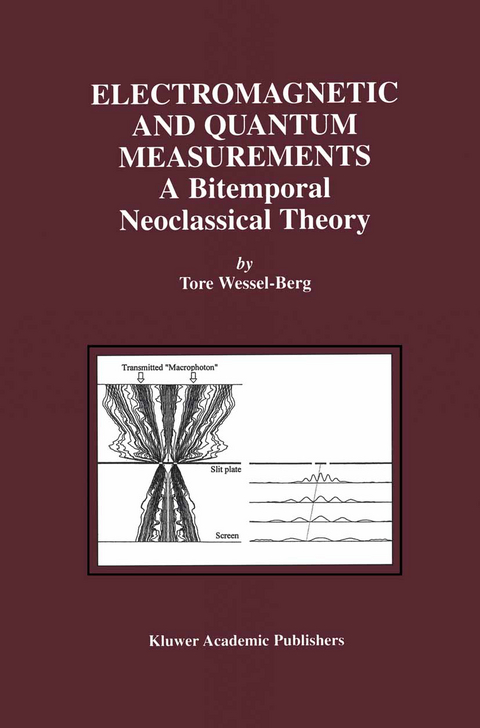
Electromagnetic and Quantum Measurements
Springer-Verlag New York Inc.
978-1-4613-5636-3 (ISBN)
It is a pleasure to write a foreword for Professor Tore Wessel-Berg's book, "Electromagnetic and Quantum Measurements: A Bitemporal Neoclassical Theory." This book appeals to me for several reasons. The most important is that, in this book, Wessel-Berg breaks from the pack. The distinguished astrophysicist Thomas Gold has written about the pressures on scientists to move in tight formation, to avoid having their legs nipped by the sheepdogs of science. This book demonstrates that Wessel-Berg is willing to take that risk. I confess that I do not sufficiently understand this book to be able to either agree or disagree with its thesis. Nevertheless, Wessel-Berg makes very cogent arguments for setting out on his journey. The basic equations of physics are indeed time-reversible. Our experience, that leads us to the concept of an "arrow of time," is derived from macro scopic phenomena, not from fundamental microscopic phenomena. For this reason, it makes very good sense to explore the consequences of treating microscopic phenomena on the assumption that forward time and backward time are equal.
1. The Causal Enigma.- 1.1 Microcosm—is it causal or bitemporal?.- 1.2 The neoclassical electromagnetic theory.- 1.3 Causal theories—incomplete in microcosm.- 2. Photons in Bitemporal Microcosm.- 2.1 Introduction.- 2.2 Plane photon pulses in the bitemporal time domain.- 2.3 The photon routing process.- 2.4 Photon doublets—the new entities.- 2.5 Concluding remarks.- 3. Neoclassical Electromagnetics.- 3.1 Definition of the generalized circuit.- 3.2 Generalized circuit equation.- 3.3 General definition of photon doublets.- 3.4 The scattering formulation of circuit response.- Appendix to Chapter 3.- 4. Are Electron Media Bitemporal?.- 4.1 Doublet interactions in collisionless plasmas.- 4.2 Bitemporal collision scattering in conductors.- 4.3 Bitemporal DC conduction in a circular wire.- 5. Photon Wave-Particle Transition.- 5.1 Introduction—the paradox.- 5.2 Classical time average macroscopic transition.- 5.3 Wave to particle transition of single photons.- 5.4 Photon emission and absorption by atoms.- 5.5 Photon wave to particle transition in striplines.- 6. Photons in General Networks.- 6.1 Classical circuit modeling.- 6.2 Single photon predicament in general circuits.- 6.3 Neoclassical theory of single photons in networks.- 7. Double Slit Experiment for Photons.- 7.1 Introduction—the paradoxes.- 7.2 Classical macroscopic model.- 7.3 Neoclassical theory of single photon routing.- 7.4 Numerical procedure of spot build up pattern.- Appendix to Chapter 7.- A.2 Slit plate scattering matrix.- 8. Double Slit Experiment for Electrons.- 8.1 Introduction—the paradoxes.- 8.2 Electromagnetic fields of the double slit plate.- 8.3 Diffraction pattern with numerical simulations.- 8.4 Neoclassical theory of electron diffraction from a single slit.- 9. The Enigmatic 1/F Noise.-9.1 What is 1/f noise?.- 9.2 Hooge’s empirical 1/f hypothesis.- 9.3 Photon excitation of 1/f noise.- 9.4 Macroscopic scattering in the radial resistor system.- 9.5 Single photon absorption and reflection at the resistor.- 9.6 Concluding remarks.- 10. Questioning Stern-Gerlach.- 10.1 Basis of the Stern-Gerlach experiment.- 10.2 The flaw in the Stern-Gerlach theory.- 11. Photon Tunneling—Superluminal?.- 11.1 Photon tunneling in a microwave configuration.- Appendix to Chapter 11.- 12. Interferometric Experiments.- 12.1 Introduction.- 12.2 Neoclassical theory of the beam splitter.- 12.3 The Mach-Zehnder interferometer.- 12.4 Mach-Zehnder delayed choice experiment.- 13. The Famous Epr Paradox.- 13.1 Introduction.- 13.2 The basic EPR configuration.- 13.3 Neoclassical theory of the EPR configuration.- 13.4 The EPR paradox in neoclassical interpretation.- 14. Quantum Bases-Neoclassical View.- 14.1 Introduction.- 14.2 Quantum principles and ‘foolish questions’.- 14.3 The uncertainty relation—how uncertain?.- 14.4 Collapse of the wave function-the measurement problem.- References.
| Zusatzinfo | 82 Illustrations, black and white; XXI, 373 p. 82 illus. |
|---|---|
| Verlagsort | New York, NY |
| Sprache | englisch |
| Maße | 155 x 235 mm |
| Themenwelt | Naturwissenschaften ► Physik / Astronomie ► Allgemeines / Lexika |
| Naturwissenschaften ► Physik / Astronomie ► Hochenergiephysik / Teilchenphysik | |
| Naturwissenschaften ► Physik / Astronomie ► Quantenphysik | |
| Naturwissenschaften ► Physik / Astronomie ► Theoretische Physik | |
| Technik ► Maschinenbau | |
| ISBN-10 | 1-4613-5636-9 / 1461356369 |
| ISBN-13 | 978-1-4613-5636-3 / 9781461356363 |
| Zustand | Neuware |
| Haben Sie eine Frage zum Produkt? |
aus dem Bereich


